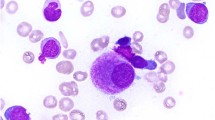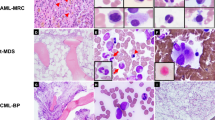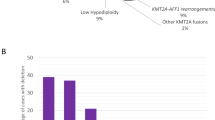Abstract
Monosomy 7 or deletions of 7q are associated with many myeloid disorders; however, the significance of such abnormalities in childhood acute lymphoblastic leukemia (ALL) is unknown. Among 1880 children with ALL, 75 (4%) had losses involving chromosome 7, 16 (21%) with monosomy 7, 41 (55%) with losses of 7p (del(7p)), 16 (21%) with losses of 7q (del(7q)), and two (3%) with losses involving both arms. Patients with losses involving chromosome 7 were more likely to be ⩾10 years old, National Cancer Institute (NCI) poor risk, and hypodiploid than patients lacking this abnormality. Patients with or without these abnormalities had similar early response to induction therapy. Event-free survival (EFS) and survival for patients with monosomy 7 (P<0.0001 and P=0.0007, respectively) or del(7p) (P<0.0001 and P=0.0001, respectively), but not of patients with del(7q), were significantly worse than those of patients lacking these abnormalities. The poorer EFS was maintained after adjustment for a Philadelphia (Ph) chromosome, NCI risk status, ploidy, or an abnormal 9p. However, the impact on survival was not maintained for monosomy 7 after adjustment for a Ph. These results indicate that the critical region of loss of chromosome 7 in pediatric ALL may be on the p-arm.
This is a preview of subscription content, access via your institution
Access options
Subscribe to this journal
Receive 12 print issues and online access
$259.00 per year
only $21.58 per issue
Buy this article
- Purchase on Springer Link
- Instant access to full article PDF
Prices may be subject to local taxes which are calculated during checkout



Similar content being viewed by others
References
Luna-Fineman S, Shannon KM, Lange BJ . Childhood monosomy 7: epidemiology, biology, and mechanistic implications. Blood 1995; 85: 1985–1999.
Le Beau MM, Albain KS, Larson RA, Vardiman JW, Davis EM, Blough RR et al. Clinical and cytogenetic correlations in 63 patients with therapy-related myelodysplastic syndromes and acute nonlymphocytic leukemia: further evidence for characteristic abnormalities of chromosomes no. 5 and 7. J Clin Oncol 1986; 4: 325–345.
Grimwade D, Walker H, Oliver F, Wheatley K, Harrison C, Harrison G et al. The importance of diagnostic cytogenetics on outcome in AML: analysis of 1,612 patients entered into the MRC AML 10 trial. The Medical Research Council Adult and Children's Leukaemia Working Parties. Blood 1998; 92: 2322–2333.
Mrozek K, Heinonen K, Bloomfield CD . Prognostic value of cytogenetic findings in adults with acute myeloid leukemia. Int J Hematol 2000; 72: 261–271.
Slovak ML, Kopecky KJ, Cassileth PA, Harrington DH, Theil KS, Mohamed A et al. Karyotypic analysis predicts outcome of preremission and postremission therapy in adult acute myeloid leukemia: a Southwest Oncology Group/Eastern Cooperative Oncology Group Study. Blood 2000; 96: 4075–4083.
Mauritzson N, Johansson B, Albin M, Rylander L, Billstrom R, Ahlgren T et al. Survival time in a population-based consecutive series of adult acute myeloid leukemia – the prognostic impact of karyotype during the time period 1976–1993. Leukemia 2000; 14: 1039–1043.
Tosi S, Scherer SW, Giudici G, Czepulkowski B, Biondi A, Kearney L . Delineation of multiple deleted regions in 7q in myeloid disorders. Genes Chromosom Cancer 1999; 25: 384–392.
Dohner K, Brown J, Hehmann U, Hetzel C, Stewart J, Lowther G et al. Molecular cytogenetic characterization of a critical region in bands 7q35–q36 commonly deleted in malignant myeloid disorders. Blood 1998; 92: 4031–4035.
Kere J, Ruutu T, Davies KA, Roninson IB, Watkins PC, Winqvist R et al. Chromosome 7 long arm deletion in myeloid disorders: a narrow breakpoint region in 7q22 defined by molecular mapping. Blood 1989; 73: 230–234.
Le Beau M, Espinosa III R, Davis EM, Eisenbart JD, Larson RA, Green ED . Cytogenetic and molecular delineation of a region of chromosome 7 commonly deleted in malignant myeloid diseases. Blood 1996; 88: 1930–1935.
Dabaja BS, Faderl S, Thomas D, Cortes J, O'Brien S, Nasr F et al. Deletions and losses in chromosomes 5 or 7 in adult acute lymphocytic leukemia: incidence, associations and implications. Leukemia 1999; 13: 869–872.
Russo C, Carroll A, Kohler S, Borowitz M, Amylon M, Homans A et al. Philadelphia chromosome and monosomy 7 in childhood acute lymphoblastic leukemia: a Pediatric Oncology Group study. Blood 1991; 77: 1050–1056.
Uckun FM, Kazimiera J, Gajl-Peczalska KJ, Provisor AJ, Heerema NA . Immunophenotype–karyotype associations in human acute lymphoblastic leukemia. Blood 1989; 73: 271–280.
Uckun FM, Reaman G, Steinherz PG, Arthur DC, Sather H, Trigg M et al. Improved clinical outcome for children with T-lineage acute lymphoblastic leukemia after contemporary chemotherapy: a Children's Cancer Group Study. Leuk Lymphoma 1996; 24: 57–70.
Hutchinson RJ, Gaynon PS, Sather H, Bertolone SJ, Cooper HA, Tannous R, et al, for the Children's Cancer Group/Children's Oncology Group. Intensification of therapy for children with lower-risk acute lymphoblastic leukemia: long-term follow-up of patients treated on Children's Cancer Group trial 1881. J Clin Oncol 2003; 21: 1790–1797.
Lange BJ, Bostrom BC, Cherlow JM, Sensel MG, La MKL, Rackoff W et al. Double-delayed intensification improves event-free survival for children with intermediate-risk acute lymphoblastic leukemia: a report from the Children's Cancer Group. Blood 2002; 99: 825–833.
Bostrom B, Sensel M, Sather H, Gaynon PS, Johnston K, La MK et al. Dexamethasone versus prednisone and daily oral versus weekly intravenous mercaptopurine for patients with standard risk acute lymphoblastic leukemia: a report from the Children's Cancer Group. Blood 2003; 101: 3809–3817.
Nachman J, Sather HN, Cherlow JM, Sensel MG, Gaynon PS, Lukens JN et al. Response of children with high-risk acute lymphoblastic leukemia treated with and without cranial irradiation: a report from the Children's Cancer Group. J Clin Oncol 1998; 16: 920–930.
Nachman JB, Sather HN, Sensel MG, Trigg ME, Cherlow JM, Lukens JN et al. Augmented post-induction therapy for children with high-risk acute lymphoblastic leukemia and a slow response to initial therapy. N Engl J Med 1998; 338: 1663–1671.
Steinherz PG, Gaynon PS, Breneman JC, Cherlow JM, Grossman NJ, Kersey JH et al. Treatment of patients with acute lymphoblastic leukemia with bulky extramedullary disease and T-cell phenotype or other poor prognostic features: randomized controlled trial from the Children's Cancer Group. Cancer 1998; 82: 600–612.
Mitelman F (ed). ISCN (1995): An International System for Human Cytogenetic Nomenclature. Basel: S Karger, 1995.
Kaplan EL, Meier P . Nonparametric estimation from incomplete observations. J Am Stat Assoc 1958; 53: 457–481.
Mantel N . Evaluation of survival data and two new rank order statistics arising in its consideration. Cancer Chemother Rep 1966; 50: 163–170.
Peto R, Pike MC, Armitage P, Breslow NE, Cox DR, Howard SV et al. Design and analysis of randomized clinical trials requiring prolonged observation of each patient. II. analysis and examples. Br J Cancer 1977; 35: 1–39.
Heerema NA, Nachman JB, Sather HN, Sensel MG, Lee MK, Hutchinson R et al. Hypodiploidy with less than 45 chromosomes confers adverse risk in childhood acute lymphoblastic leukemia: a report from the Children's Cancer Group. Blood 1999; 94: 4036–4046.
Uckun FM, Nachman JB, Sather HN, Sensel MG, Kraft P, Steinherz PG et al. Clinical significance of Philadelphia chromosome-positive pediatric acute lymphoblastic leukemia in the context of contemporary intensive therapies: a report from the Children's Cancer Group. Cancer 1998; 83: 2030–2039.
Heerema NA, Sather HN, Sensel MG, Kraft P, Nachman JB, Steinherz PG et al. Frequency and clinical significance of cytogenetic abnormalities in pediatric T-lineage acute lymphoblastic leukemia: a report from the Children's Cancer Group. J Clin Oncol 1998; 16: 1270–1278.
Heerema NA, Sather HN, Sensel MG, Hutchinson RJ, Nachman JB, Reaman GH et al. Abnormalities of chromosome bands 15q13–15 in childhood acute lymphoblastic leukemia. Cancer 2002; 94: 1102–1110.
Uckun FM, Sensel MG, Sather HN, Gaynon PS, Arthur DC, Lange B et al. Clinical significance of translocation t(1;19) in childhood acute lymphoblastic leukemia in the context of contemporary therapies: a report from the Children's Cancer Group. J Clin Oncol 1998; 16: 527–535.
Heerema NA, Sather HN, Sensel MG, Lee MK, Hutchinson RJ, Nachman JB et al. Abnormalities of chromosome bands 13q12 to 13q14 in childhood acute lymphoblastic leukemia. J Clin Oncol 2000; 18: 3837–3844.
Heerema NA, Sather HN, Sensel MG, Zhang T, Hutchinson RJ, Nachman JB et al. Prognostic impact of trisomies of chromosomes 10, 17, and 5 among children with acute lymphoblastic leukemia and high hyperdiploidy (>50 chromosomes). J Clin Oncol 2000; 18: 1876–1887.
Harris MB, Shuster JJ, Carroll A, Look AT, Borowitz MJ, Crist WM et al. Trisomy of leukemic cell chromosomes 4 and 10 identifies children with B-progenitor cell acute lymphoblastic leukemia with a very low risk of treatment failure: a Pediatric Oncology Group study. Blood 1992; 79: 3316–3324.
Smith M, Arthur D, Camitta B, Carroll AJ, Crist W, Gaynon P et al. Uniform approach to risk classification and treatment assignment for children with acute lymphoblastic leukemia. J Clin Oncol 1996; 14: 18–24.
Gaynon PS, Desai AA, Bostrom BC, Hutchinson RJ, Lange BJ, Nachman JB et al. Early response to therapy and outcome in childhood acute lymphoblastic leukemia: a review. Cancer 1997; 80: 1717–1726.
Heerema NA, Sather HN, Sensel MG, Liu-Mares W, Lange BJ, Bostrom BC et al. Association of chromosome arm 9p abnormalities with adverse risk in childhood acute lymphoblastic leukemia: a report from the Children's Cancer Group. Blood 1999; 94: 1537–1544.
Author information
Authors and Affiliations
Corresponding author
Rights and permissions
About this article
Cite this article
Heerema, N., Nachman, J., Sather, H. et al. Deletion of 7p or monosomy 7 in pediatric acute lymphoblastic leukemia is an adverse prognostic factor: a report from the Children's Cancer Group. Leukemia 18, 939–947 (2004). https://doi.org/10.1038/sj.leu.2403327
Received:
Accepted:
Published:
Issue Date:
DOI: https://doi.org/10.1038/sj.leu.2403327
Keywords
This article is cited by
-
ETV6–ABL1 fusion combined with monosomy 7 in childhood B-precursor acute lymphoblastic leukemia
International Journal of Hematology (2018)
-
An adult B-cell precursor acute lymphoblastic leukemia with multiple secondary cytogenetic aberrations
Molecular Cytogenetics (2014)
-
Biclonal myelodysplastic syndrome involving six chromosomes and monoallelic loss of RB1 - A rare case
Molecular Cytogenetics (2011)
-
Additional chromosomal abnormalities and their prognostic significance in adult Philadelphia-positive acute lymphoblastic leukemia: with or without imatinib in chemotherapy
Annals of Hematology (2009)
-
Genome complexity in acute lymphoblastic leukemia is revealed by array-based comparative genomic hybridization
Oncogene (2007)



